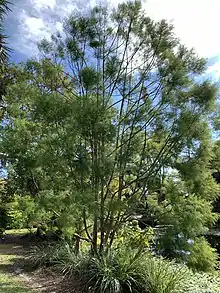Gymnostoma sumatranum
Gymnostoma sumatranum is a tree in the she-oak family, Casuarinaceae, native to Southeast Asia and the Malesia region.
| Gymnostoma sumatranum | |
|---|---|
 | |
| Scientific classification | |
| Kingdom: | Plantae |
| Clade: | Tracheophytes |
| Clade: | Angiosperms |
| Clade: | Eudicots |
| Clade: | Rosids |
| Order: | Fagales |
| Family: | Casuarinaceae |
| Genus: | Gymnostoma |
| Species: | G. sumatranum |
| Binomial name | |
| Gymnostoma sumatranum | |
Distribution
Areas where the tree is native include Burma, Sumatra, Borneo, Java, Kalimantan, Malaysia, Sulawesi (Indonesia), Western New Guinea, and the Philippines.
In Malaysia, G. sumatranum is known as Rhu Bukit — with bukit in Malaysian meaning "hill". The other common she-oak species in Malaysia is Casuarina equisetifolia known as Rhu laut - laut in Malaysian means "sea" and typically it grows along the seashore on sandy substrates. In Sarawak it is a protected species (5). G. sumatranum typically grows further inland. However, when occurring in coastal regions, it provides good indication that the soil is dry and out of the littoral and inundation zone since G. sumatranum will not normally tolerate sandy or boggy soil.
Description
Gymnostoma sumatranum is characterised by its multiple rounded umbrella-shaped crowns, while Casuarina equisetifolia (the most well-known member of Casuarinaceae) is typified by its equisetoid appearance. The roots have nitrogen-fixing nodules.
The stems are angular or tetrahedal in cross section (2). Like the other members of the family Casuarinaceae, they are characterized by drooping equisetoid (meaning "to look like Equisetum") twigs, are evergreen, and monoecious or dioecious.
The foliage of this tropical angiosperm tree looks like that of gymnosperm pine trees which typically grow in temperate climates. The stomata are not restricted to sunken grooves (2).
The female inflorescences are borne terminally (2).
References
- Dilcher, D. L. et al.. (1990) Evolution of the Casuarinaceae: morphological comparisons of some extant species. American journal of Botany. 77(3): 338-355. 1990.
- P. S. Green, Klaus Kubitzki, E. Götz, K. U. Kramer. (1990) The Families and Genera of Vascular Plants. Published by springer. 404 pages
- Jane N. Prider and David C. Christophel Distributional ecology of Gymnostoma australianum (Casuarinaceae), a putative palaeoendemic of Australian wet tropic forests. Australian Journal of Botany 48(4) 427 - 434
- Barlow, B.A., (1983). Casuarina Ecology,. Management and Utilization. edited by S.J.Midgely. pp. 10–18
- Sarawak Forestry ordinance 1998